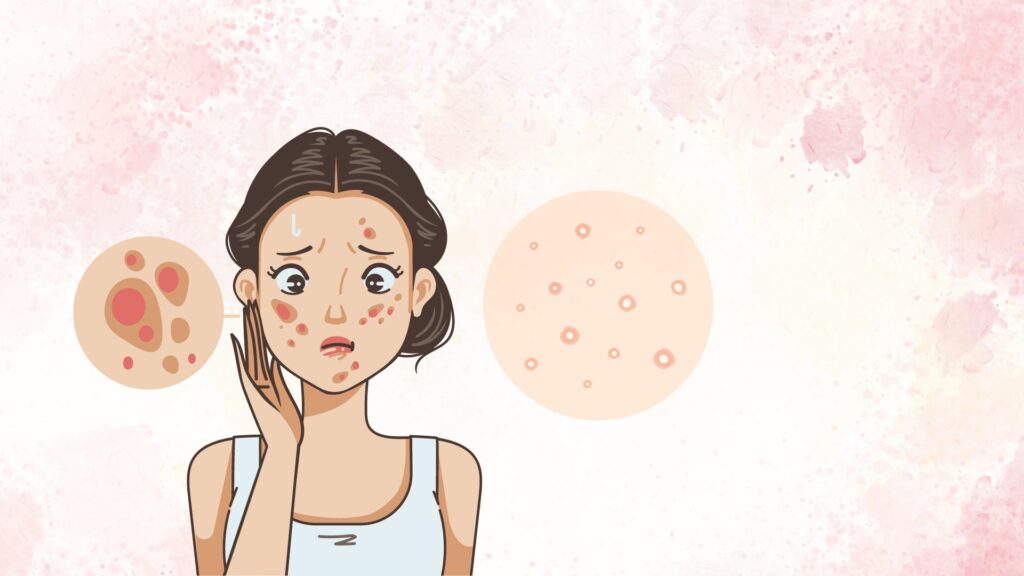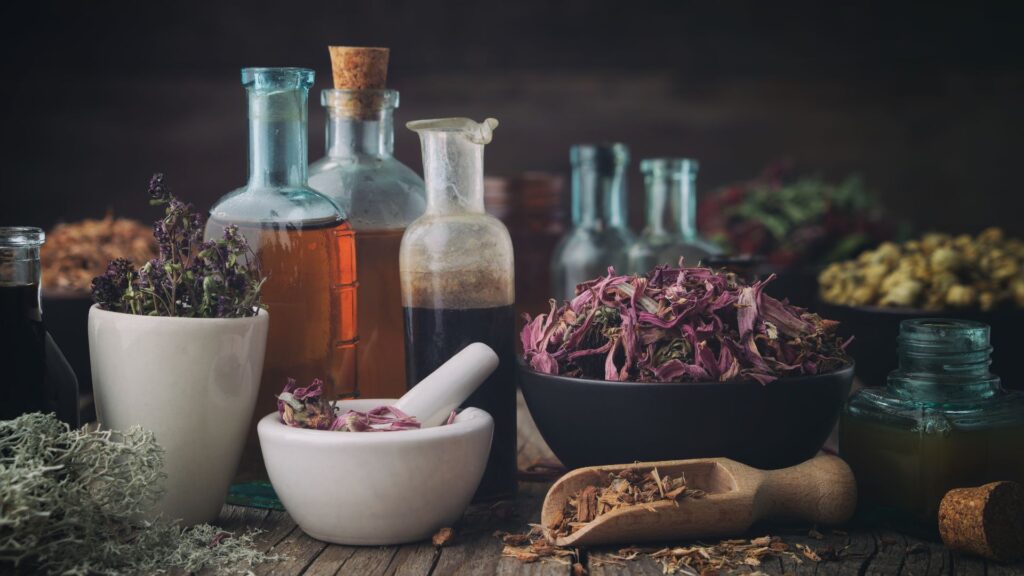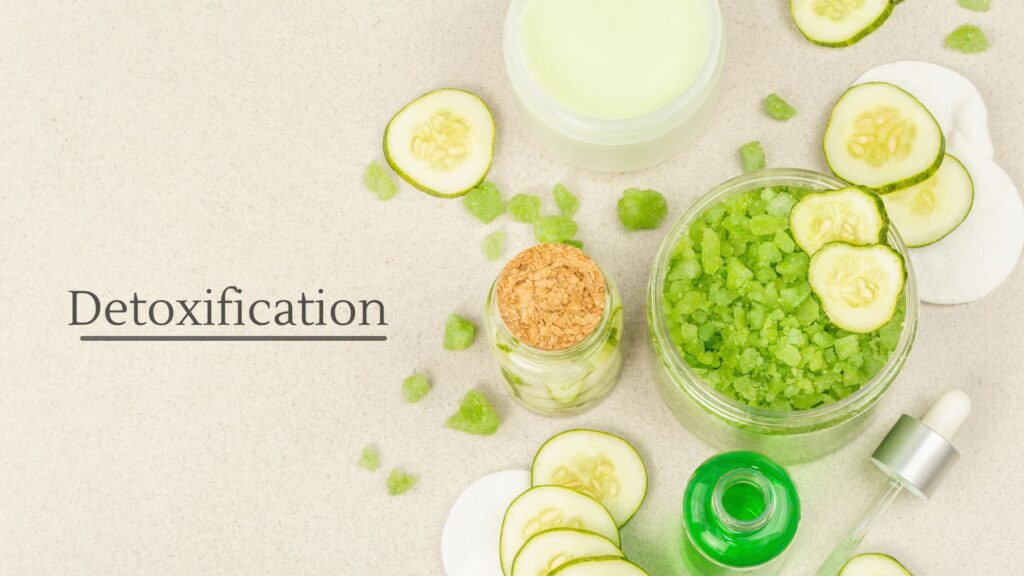
Acne is a common skin condition characterized by the formation of pimples, blackheads, whiteheads, or cysts on the skin, typically on the face, neck, chest, back, and shoulders. It happens when hair follicles get clogged with oil and dead skin cells. Factors contributing to acne include excess oil production, the accumulation of dead skin cells, the presence of bacteria such as hormonal changes, and genetic factors. Treatment options range from over-the-counter topical medications to prescription drugs and may include lifestyle modifications and skincare routines.
Ayurveda, our ancient system of medicine, offers holistic acne solutions that focus on balancing the body’s doshas (energies) and addressing underlying imbalances rather than just treating the symptoms. In this article, we will explore how Ayurvedic acne treatment can help you say goodbye to those annoying breakouts to achieve clear and healthy skin. Here’s a detailed overview :

1.Identify Dosha Imbalance:
According to Ayurveda, acne can be caused by an imbalance in any of the three doshas: Vata, Pitta, and Kapha. Doshas are elemental energies that govern various physiological and psychological functions in the body. Acne is believed to result from an excess of Pitta dosha, which represents the elements of fire and water. When Pitta is aggravated, it can lead to inflammation, excess oil production, and the accumulation of toxins in the body, all of which contribute to the development of acne.
Additionally, imbalances in Vata and Kapha doshas can also play a role in acne formation, as they influence factors such as circulation, moisture levels, and detoxification processes. Ayurvedic treatments for acne typically involve rebalancing the doshas through dietary adjustments, herbal remedies, lifestyle modifications, and stress reduction techniques to address the root cause of the imbalance and promote clear, healthy skin. Understanding your predominant dosha can help tailor your treatment approach.

2.Dietary Modifications:
Dietary modifications tailored to address dosha imbalances can be instrumental in managing acne according to Ayurvedic principles. For individuals with Pitta dosha imbalance, emphasizing cooling and calming foods is crucial to alleviate inflammation and excess heat associated with acne.
This includes incorporating sweet, bitter, and astringent tastes while minimizing spicy, oily, and acidic foods that can aggravate Pitta. For Vata imbalance, focusing on nourishing, grounding foods can help improve circulation and prevent dryness, which may contribute to acne. Additionally, for those with Kapha imbalance, it’s essential to reduce heavy, oily foods and promote light, detoxifying options to prevent excessive oil production and congestion in the skin.
A balanced diet rich in fresh fruits, vegetables, whole grains, lean proteins, and healthy fats, along with adequate hydration, can support overall dosha balance and promote clearer skin.

3.Herbal Remedies:
Neem: Neem is known for its antibacterial, antifungal, and blood-purifying properties. It helps in detoxifying the blood and reducing inflammation associated with acne. Neem leaves can be used to make a paste and applied directly to the affected areas or consumed as neem capsules or neem tea.
Turmeric: Turmeric has strong anti-inflammatory and antimicrobial properties. It can be applied topically as a paste with water or honey onto acne-prone skin or taken internally by adding it to food or drinks.
Aloe Vera: Aloe vera has soothing and healing properties that can help reduce inflammation and redness associated with acne. Its gel can be applied topically to the affected areas or consumed orally.
Tulsi: Tulsi is known for its antibacterial, antifungal, and antioxidant properties. It helps in purifying the blood and reducing acne breakouts. Tulsi leaves can be chewed daily or made into a paste and applied topically.
Sandalwood: Sandalwood has cooling and soothing properties that help reduce inflammation and promote healing. Sandalwood paste with water applied to the affected area may be helpful.
Triphala: Triphala is a combination of three herbs/fruits namely Amalaki, Bibhitaki, and
Haritaki. It helps in detoxifying the body, improving digestion, and promoting skin health. Triphala powder can be consumed internally or used topically as a paste.
Manjistha: Manjistha has blood-purifying and detoxifying properties. It helps in flushing out toxins from the body and reducing inflammation associated with acne. Manjistha powder can be consumed internally or applied topically as a paste.
Guggulu: Guggulu is a resin that is extracted from Commiphora mukul tree. It has anti-inflammatory and antimicrobial properties and helps in reducing acne breakouts.

4.Detoxification:
Panchakarma is a comprehensive Ayurvedic detoxification therapy that includes various cleansing procedures like Vamana (emesis), Virechana (purgation), and Nasya (nasal administration of medicated oils). Panchakarma can help eliminate toxins from the body and restore balance to the doshas, thereby improving skin health.

5.Lifestyle Modifications:
Stress Management: Stress is considered a significant factor in aggravating acne in Ayurveda. Practice Yoga, meditation, and deep breathing exercises to manage stress.
Adequate sleep is essential for balancing the body’s energies. Avoid sleeping too late at night.
Skincare Routine: Use gentle, natural skincare products that are suitable for your skin type. Avoid harsh chemical-based products that may further irritate the skin. Cleanse the skin regularly to remove excess oil, dirt, and impurities. Exfoliate the skin weekly to unclog pores and remove dead skin cells. Use natural exfoliants like oatmeal or chickpea flour mixed with water or rose water. Apply cooling and soothing face packs made from ingredients like sandalwood, neem, turmeric, or rose water to reduce inflammation and redness.
Physical Activity: Engage in regular exercise to improve circulation and detoxification of the body. Activities such as walking, swimming, or yoga may be helpful.
Hygiene Practices: Keep your face clean by washing it with a mild cleanser twice a day, especially after sweating. Avoid touching your face with dirty hands to prevent the spread of bacteria.
It’s advisable to consult with a qualified Ayurvedic practitioner who can assess your dosha constitution and prescribe personalized treatment recommendations tailored to your specific needs. Ayurvedic treatments for acne may take time to show results as they focus on addressing the root cause rather than providing quick fixes. Consistency and patience are key to achieving long-lasting improvements in acne and overall skin health.
